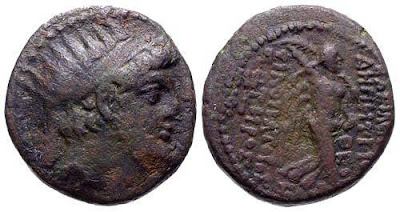
AR Drachm, 17mm, 4.10g., 1 h., Antioch mint, likely minted in late Spring of BCE 129 to Spring BCE 128.
SC 2167b, De Clercq 203; Paris R2254, SNG Spaer 2163-4 var., (same obv. die, different monogram), SMA--, Babelon 1221=De Luynes 3394 var., (same obv. die, different monogram); BMC Seleucid--, CSE---.
O: diad hd of Demetrius r., bearded, with hair combed smooth on crown of hd, diad ends falling straight behind, fillet border.
R: BAΣΙΛΕ[ΩΣ] ΔΗMHTPIO[Y ]in two lines on r., ΘEOY NIKATOP[OΣ] in two lines on the l., Zeus enthroned l resting on sceptre and holding Nike inside inscription, facing r., offering wreath to Zeus. Controls in ex., primary on the left Ξ, then AM (?) to r.
This coin is the plate coin for SC 2167b in SC II found in Plate 40 though is incorrectly identified as De Clercq 203, when in fact it is not. De Clercq 203 can be viewed at this link at the BNF as it remains in the BNF collection and the example noted above is superior to the BNF examples.
https://gallica.bnf.fr/ark:/12148/btv1b8574723w
Ex: Sayles & Lavender
Ex: CNG EA 107:92 (2005)
Ex: Jean Elsen 73:127 (2003) The Elsen Auction description and information follows:
"D/ Tête barbue et diadémée à d. R/ [Légende en grec] Zeus trônant à g., tenant une petite Niké et un long sceptre. A l'exergue, [lettres grecques]. Quality: about Very Fine. Estimate: 200 euro. Sold at 220 euro + 18% buyer's fee." (email from R. Dus at Elsen 01-2009)
cf. Schwei, D. "The Reactions of Mint Workers to the Tumultuous Second Reign of Demetrius II Nicator"
AJN Second Series 28 (2016) pp. 65-104.
This coin catalogued on page 90 under the Antioch Drachms as #7 (dies a1/p6)
CNG noted that this coin was "Rare" as well as the following:
"Newell, in SMA, analyzed the coinage of Demetrios' second reign at Antioch: It was a large, but short, issue probably struck to fund his military campaign to help Cleopatra II take Egypt from Ptolemy VIII. After Demetrios departed, however, Antioch revolted, allowing an Egyptian army to enter and install Alexander II Zebina as king. Unable to regain the northern part of his kingdom, Demetrios was murdered in Tyre. The fact that this issue shares the same obverse die with a wide variety of reverse dies supports Newell's theory of a short, massive coinage."
cf. Newell, SMA pp. 83-84
cf. Bevan, THE HOUSE OF SELEUCUS, pp. 248-249 (v. II)
CNG was likely in error noting that it was struck circa "126/5 BC". Demetrius had vacated Antioch in BCE 128.
This is another example of the same coin likely from the same dies but certainly same reverse die since the die crack that extends from 10-12 o'clock on the upper left is apparent in the above example as it is in this example.
This example is Ex Superior sale 1988, 2032. From the Harlad Salvesen collection as well as Ex Numismatica Ars Classica NAC AG Auction 106 lot 335 (09.05.2018)






















 John Quincy Adams c. 1843
John Quincy Adams c. 1843

























